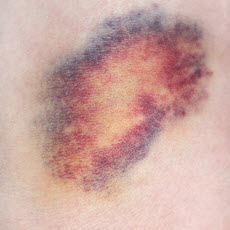Closed Soft Tissue Injuries
Published (updated: ).
Contusion

A bruise is a mark on your skin caused by blood trapped under the surface. It happens when an injury crushes small blood vessels but does not break the skin. Those vessels break open and leak blood under the skin. Bruises are often painful and swollen. You can get skin, muscle and bone bruises. Bone bruises are the most serious.
It can take months for a bruise to fade, but most last about two weeks. They start off a reddish color, and then turn bluish-purple and greenish-yellow before returning to normal. To reduce bruising, ice the injured area and elevate it above your heart.
Hematoma

A pool of mostly clotted blood that forms in an organ, tissue, or body space. A hematoma is usually caused by a broken blood vessel that was damaged by surgery or an injury. It can occur anywhere in the body, including the brain. Most hematomas are small and go away on their own, but some may need to be removed by surgery.
Crush Injuries

Crush Injury and Crush Syndrome
Crush injury is defined as compression of extremities or other parts of the body that causes muscle swelling and/or neurological disturbances in the affected areas of the body. Typically affected areas of the body include lower extremities (74%), upper extremities (10%), and trunk (9%). Crush syndrome is localized crush injury with systemic manifestations. These systemic effects are caused by a traumatic rhabdomyolysis (muscle breakdown) and the release of potentially toxic muscle cell components and electrolytes into the circulatory system. Crush syndrome can cause local tissue injury, organ dysfunction, and metabolic abnormalities, including acidosis, hyperkalemia, and hypocalcemia.
Previous experience with earthquakes that caused major structural damage has demonstrated that the incidence of crush syndrome is 2-15% with approximately 50% of those with crush syndrome developing acute renal failure and over 50% needing fasciotomy. Of those with renal failure, 50% need dialysis.
Sudden release of a crushed extremity may result in reperfusion syndrome—acute hypovolemia and metabolic abnormalities. This condition may cause lethal cardiac arrhythmias. Further, the sudden release of toxins from necrotic muscle into the circulatory system leads to myoglobinuria, which causes renal failure if untreated.
Hypotension
- Massive third spacing occurs (too much fluid moves from the intravascular space (blood vessels) into the interstitial or “third” space—the nonfunctional area between cells), requiring considerable fluid replacement in the first 24 hours; Patients may sequester (third space) >12 L of fluid in the crushed area over a 48-hour period
- Third spacing may lead to secondary complications such as compartment syndrome, which is swelling within a closed anatomical space; compartment syndrome often requires fasciotomy
- Hypotension may also contribute to renal failure
Renal Failure
- Rhabdomyolysis releases myoglobin, potassium, phosphorous, and creatinine into the circulation
- Myoglobinuria may result in renal tubular necrosis if untreated
- Release of electrolytes from ischemic muscles causes metabolic abnormalities
Metabolic Abnormalities
- Calcium flows into muscle cells through leaky membranes, causing systemic hypocalcemia
- Potassium is released from ischemic muscle into systemic circulation, causing hyperkalemia
- Lactic acid is released from ischemic muscle into systemic circulation, causing metabolic acidosis
- Imbalance of potassium and calcium may cause life-threatening cardiac arrhythmias, including cardiac arrest; metabolic acidosis may exacerbate this situation
Initial Management
Prehospital setting:
Consider short-term use of a tourniquet on the affected limb until intravenous (IV) hydration can be initiated
